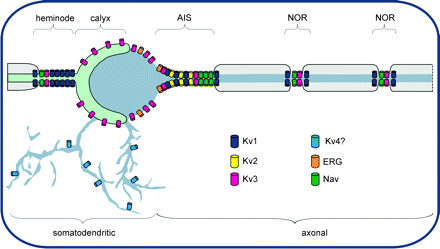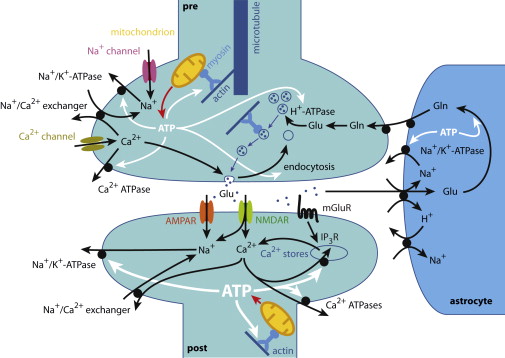General
Projects
Resource and energy usage in a neural system
In an BBSRC-funded collaboration with Prof. Ian Forsythe (Cell Physiology and Pharmacology, Leicester) and Dr Matthias Hennig (Informatics, Edinburgh) we are studying how the availability of resources (ion channels, synaptic vesicles etc) and the consumption of energy affect the function and configuration of a particular neural system: the calyx of Held / MNTB principle neuron complex in the brainstem auditory system.
Overview [top]
We will use a systems biology approach, consisting of a tightly integrated programme of experiments and computational modelling, to study activity-dependent regulation in the medial nucleus of the trapezoid body (MNTB) in the mammalian auditory brainstem, which plays a key role in sound source localisation (SSL). We will examine how different intrinsic plasticity mechanisms, evoked by incoming neural activity, obtain satisfactory functional performance in this nucleus from a limited set of noisy resources (neurons, ion channels, synapses etc) while minimising energy usage. Experimental recordings will be made in tissue slices from mouse. A combination of electrophysiology, pharmacology, immunohistochemistry and genetic manipulation will provide data on the resource distribution in the MNTB neurons and associated calyx of Held synapse, and the regulation of these resources by activity. The experimental data will be used to fit the parameters of a computational model, which will be in the form of a Hodgkin-Huxley-style compartmental model of an MNTB neuron and its synapse. The model will include heterogeneous distributions of identified ion channels types, stochastic neurotransmitter release, and multiple mechanisms of short-term synaptic plasticity. Advanced statistical optimisation techniques will be used to fit model parameters. The model will be analysed to determine information transmission through this system and associated energy usage as estimated by ATP consumption. We postulate that the amount of information transmitted as a fraction of energy used will be different between the high sound frequency and low sound frequency poles of the MNTB.
Results [top]
The computational models were fit to experimental data from the calyx of Held / Medial Nucleus of the Trapezoid Body (MNTB) synaptic pathway in the mammalian auditory brain stem. This pathway must be capable of transmitting high frequency signals with precise timing in response to sound stimuli to allow, in particular, sound source localisation. Our major objective was to explore the hypothesis that synaptic transmission at the calyx of Held and excitability in the postsynaptic MNTB neuron are dynamically regulated in an activity-dependent manner to maintain both functional signal transmission and metabolic efficiency. Our key findings do support this hypothesis:
- Synaptic transmission is an energy-intensive process: experiments show that depletion of ATP (the key end-effector molecule in metabolic processes) results in failures of both pre- and post-synaptic action potential (AP) firing and a decrease in postsynaptic receptor currents even when presynaptic APs are still occurring (Lucas et al, 2015).
- Computational modelling has allowed us to assay the energy demands of the biophysical processes underlying synaptic transmission in the presynaptic terminal and postsynaptic cell. While maintaining ion concentration gradients makes major energy demands, neurotransmitter vesicle recycling and release are also energy intensive and their impairment underlies the decrease in synaptic currents seen in experiments when ATP is depleted in the presynaptic terminal (Michel et al, 2015c).
- Nitric oxide (NO) is a neuromodulator that is produced in an activity-dependent manner in the MNTB neurons and has a multitude of effects both pre- and post-synaptically, such as a rebalancing of ion channels to allow the transmission of high frequency signals (hundreds of Hertz) through this synaptic pathway. Our computational models indicate that NO not only improves signal throughput, but also configures the pre- and post-synaptic compartments to be more energy efficient (Michel and Graham, 2015b, Michel et al, 2014).
During this work we have developed an algorithm for identifying neuronal membrane-bound ion channel dynamics from limited electrophysiological data. This algorithm could be employed in neuroscientific studies of neuron characteristics throughout the brain, and potentially minimises the number of experiments that need to be carried out to collect the required data (Michel et al, 2015a).
This is not the end of the story and work is continuing to refine the models as we obtain more experimental data. In particular, we need to further integrate the metabolic and synaptic transmission biochemical pathways to produce a truly comprehensive picture of this synapse that can be used as a platform for exploring in detail the impact of key components on metabolism and neurotransmitter cycling, and hence signal throughput by chemical synapses.
See also our earlier work on the calyx of Held synapse.
Funding [top]
- 2013-2016
- BBSRC Grant BB/K01854X/1, "Balancing resource and energy usage for optimal performance in a neural system", B. Graham. This grant employs a research fellow (Dr Christophe Michel). It is joint with BB/K01899X/1, I. Forsythe (Leicester) and BB/K017950/1, M. Hennig (Edinburgh).
- CB Michel, SJ Lucas, MH Hennig, ID Forsythe, BP Graham (2016) An evaluation of short-term plasticity parameters at the calyx of Held during high and low presynaptic ATP concentrations. FENS Forum, Copenhagen, July 2016. (poster)
- SJ Lucas, CB Michel, Y Sweeney, MH Hennig, BP Graham & ID Forsythe (2015). ATP depletion suppresses action potential firing independently of synaptic transmission. Program No. XXX.XX. 2015 Neuroscience Meeting Planner. Washington, DC: Society for Neuroscience, 2015. Online.(poster)
- Michel C., Azevedo Coste C., Desmadryl G., Puel J-L., Bourien J. and Graham B. (2015a) Identification and modelling of fast and slow current components in vestibular ganglion neurons. European Journal of Neuroscience 42(10):2867-2877.
- CB Michel, BP Graham (2015b) Activity-Dependent Regulation Decreases Metabolic Cost in the Auditory Brainstem. 7th International IEEE EMBS Conference on Neural Engineering (NER), Montpellier, France, April 2015. Book Series: International IEEE EMBS Conference on Neural Engineering. Pages: 312-315. Published: 2015. INSPEC Accession Number: 15287134. DOI: 10.1109/NER.2015.7146622
- CB Michel, SJ Lucas, ID Forsythe, BP Graham (2015c) Computational modelling predicts activity-dependent neuronal regulation by nitric oxide increases metabolic pathway activity. Computational Neuroscience Conference (CNS*2015). Prague, Czech Republic, July 2014. BMC Neuroscience 2015, 16(Suppl 1):P84 (poster)
- CB Michel, MH Hennig, BP Graham (2014) Nitric oxide activity-dependent regulator compensates synaptic depression and enhances metabolic efficiency in the auditory brainstem. Computational Neuroscience Conference (CNS*2014). Quebec City, Canada, July 2014. BMC Neuroscience 2014, 15(Suppl 1):P154 (21 July 2014)
Background Reading [top]
J.J. Harris, R. Jolivet, D. Attwell (2012) Synaptic energy use and supply. Neuron 75(5):762–777.
J. Johnston, I.D. Forsythe, C. Kopp-Scheinpflug (2010) Going native: voltage-gated potassium channels controlling neuronal excitability. Journal of Physiology, 588, 3187-3200.

